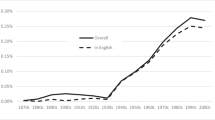Abstract
The ‘vast majority of incomes ratio (VMIR)’ R 0 is the ratio of the average income µ 0 of a poorest majority p 0 of the population to the overall average income µ. Another measure of equality is E 0=(1-G) , where G is the Gini coefficient of inequality of the distribution. Shaikh and Ragab (2007, 2008), employing a wide variety of data sets, have shown (among other things), that when p 0 is 70 %, R 0 serves as a uniformly stable and excellent approximation of E 0. We extend the Shaikh-Ragab findings in two directions. We explore some analytics of the relationship between R 0 and E 0 for a lognormal distribution; and we derive a couple of other V M I R s and related measures of welfare which are distinct from but inspired by the Shaikh-Ragab formulations.
Similar content being viewed by others
References
Bhattacharya N. and Mahalanobis B. (1967). Regional disparities in household consumption in India. J. Am. Stat. Assoc. 62, 143–161.
Dragulescu A. and Yakovenko V.M. (2001). Evidence for the exponential distribution of income in the USA. Eur. Phys. J. B 20, 585–589.
Dragulescu A. and Yakovenko V.M. (2002). Statistical mechanics of money, income and wealth: a short survey. arXiv:cond-mat/0211175, vol. 1, pp. 1–4.
Fleurbaey M. and Mongin P. (2005). The news of the death of welfare economics is greatly exaggerated. Soc. Choice Welf. 25, 381–418.
Foster J.E. and Ok E. (1999). Lorenz dominance and the variance of logarithms. Econometrica 67, 901–907.
Gruen C. and Klasen S. (2008). Growth, inequality and welfare: comparisons across space and time. Oxford Economics Papers 60, 212–236.
Lambert P.J. (1989). The Distribution and Redistribution of Income: A Mathematical Analysis. Basil Blackwell, Oxford.
Lambert P.J. (2011). Positional Equity and Equal Sacrifice: Design Principles For an EU- Wide Income Tax? In Social Ethics And Normative Economics: Essays in Honour of Serge-Christophe Kolm. (M. Fleurbaey, M. Salles and J. A. Weymark, eds.). Springer-Verlag series Studies in Choice and Welfare, Berlin, pp. 241–259.
Osmani S.R. (1982). Economic Inequality and Group Welfare: A Theory of Comparison with Application to Bangladesh. Clarendon Press, Oxford.
SEN A. (1976). Real national income. Rev. Econ. Stud. 43, 19–39.
Shaikh A. and Ragab A. (2007). An international comparison of the incomes of the vast majority. SCEPA Working Paper 2007-3, Schwartz Center for Economic Policy Analysis, The New School, New York.
Shaikh A. and Ragab A. 2008 The Vast Majority Income (VMI): A New Measure of Global Inequality. Policy Research Brief No. 7, International Poverty Centre, Brazil.
Shorrocks A.F. (1983). Ranking income distributions. Economica 50, 1–17.
Silva C.A. and Yakovenko V.M. (2004). Temporal evolution of the thermal and superthermal income classes in the USA during 1983–2001. Europhys. Lett. 3, 1–7.
Subramanian S. (2010). Tricks with the Lorenz curve. Econ. Bull. 30, 1594–1602.
Author information
Authors and Affiliations
Corresponding author
Rights and permissions
About this article
Cite this article
Lambert, P.J., Subramanian, S. Shaikh and Ragab’s Incomes of the Vast Majority: Some Additions and Extensions. Sankhya B 77, 359–370 (2015). https://doi.org/10.1007/s13571-015-0101-7
Received:
Published:
Issue Date:
DOI: https://doi.org/10.1007/s13571-015-0101-7
Keywords and phrases
- Vast majority of incomes ratio
- Lognormal distribution
- Gini coefficient
- Lorenz Curve
- Sen’s welfare index.




